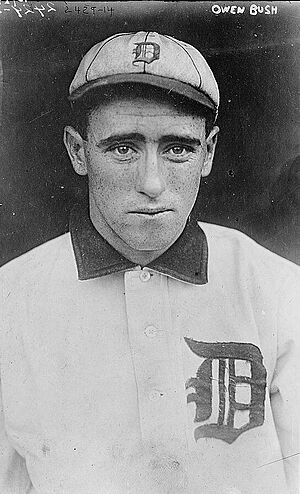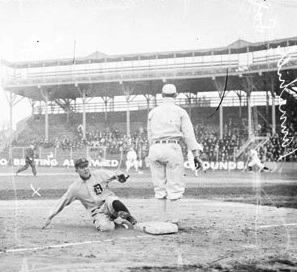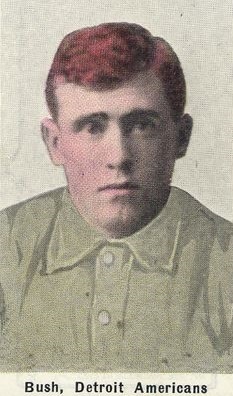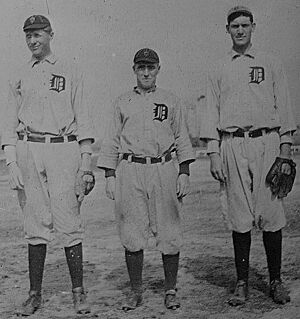Donie Bush facts for kids
Quick facts for kids Donie Bush |
|||
|---|---|---|---|

Bush in 1910 with the Detroit Tigers
|
|||
| Shortstop / Manager | |||
| Born: October 8, 1887 Indianapolis, Indiana, U.S. |
|||
| Died: March 28, 1972 (aged 84) Indianapolis, Indiana, U.S. |
|||
|
|||
| debut | |||
| September 18, 1908, for the Detroit Tigers | |||
| Last appearance | |||
| September 15, 1923, for the Washington Senators | |||
| MLB statistics | |||
| Batting average | .250 | ||
| Home runs | 9 | ||
| Runs batted in | 436 | ||
| Stolen bases | 404 | ||
| Managerial record | 497–539 | ||
| Winning % | .480 | ||
| Teams | |||
As player
As manager
|
|||
Owen Joseph "Donie" Bush (born October 8, 1887 – died March 28, 1972) was an American baseball legend. He was a professional baseball player, manager, team owner, and scout. Donie was involved in professional baseball for a very long time, from 1905 until he passed away in 1972.
Bush was the main shortstop for the Detroit Tigers from 1908 to 1921. He also played for the Washington Senators from 1921 to 1923. People thought he was one of the best defensive shortstops of his time. He made more putouts and assists than any other shortstop back then. His 425 putouts in 1914 are still an American League record for shortstops!
Even though he wasn't known for hitting many home runs, Bush was great at getting on base. He often led the league in walks, sacrifice hits, stolen bases, and runs scored. When he retired in 1923, his 1,158 walks were the second most in baseball history. He also stole 400 bases for the Tigers, which is second only to the famous Ty Cobb in team history.
Donie Bush also had a successful career as a manager. He led the Pittsburgh Pirates to the National League championship in 1927. He managed several other teams, including the Indianapolis Indians and Minneapolis Millers. He was even a co-owner and president of the Indianapolis Indians for many years. Because of his long and important career, he was called "King of Baseball" in 1963. In Indianapolis, he was known as "Mr. Baseball."
Contents
Early Life & Beginnings
Donie Bush was born in 1887 in Indianapolis, Indiana. His parents were Irish-American, and he grew up on the east side of Indianapolis. His father died when Donie was young. He lived with his mother and two older siblings in Indianapolis.
Playing Baseball
Donie Bush was known as an amazing defensive shortstop. He made many incredible plays. In 1914, he set a Major League record for shortstops with 425 putouts. He also holds a Major League record for being part of nine triple plays.
As a batter, Bush was great at getting on base. He led the American League in walks five times. From 1910 to 1919, no other player in the Major Leagues had more walks than Donie Bush. He also had 337 sacrifice hits in his career, which is one of the highest totals ever.
Bush was a smaller player, standing at five feet, six inches tall. He weighed between 130 and 140 pounds. He once joked that he would compare heights with other small players, and they were always an inch taller than him!
His nickname "Donie" came from a teammate, Ed Killian, in 1909. After Bush missed a pitch, Killian called it a "donie ball." The name stuck, even though Donie never knew what a "donie ball" was!
- Career Stats
| G | AB | R | H | 2B | 3B | HR | RBI | SB | CS | BB | SO | BA | OBP | SLG | TB | SH | HBP |
| 1946 | 7210 | 1280 | 1804 | 186 | 74 | 9 | 436 | 404 | 75 | 1158 | 346 | .250 | .356 | .300 | 2165 | 337 | 29 |
Starting in the Minor Leagues
Bush started his baseball journey in 1905. He played for several minor league teams, including the Sault Ste. Marie Soos and the Zanesville Moguls. In 1907, he played for the South Bend Greens. People said he was the best all-around shortstop the Central League had ever seen.
In 1908, he played for the Indianapolis Browns. He was their starting shortstop and helped them win the American Association championship. Many believed he was the best minor league player that year.
Joining the Detroit Tigers
In late 1908, the Detroit Tigers bought Donie Bush. He joined the team in September when their regular shortstop was hurt. Bush played so well in the last 20 games that he helped the Tigers win the American League championship! However, he couldn't play in the 1908 World Series because he hadn't been with the team long enough.
Becoming a Star Shortstop
In 1909, Donie Bush became the Tigers' full-time shortstop. He had a great year, leading the American League in walks and sacrifice hits. His 52 sacrifice hits that year are still one of the highest totals ever in a single season. He also stole 52 bases, setting a rookie record that lasted for 83 years!
Bush also played in the 1909 World Series against the Pittsburgh Pirates. While famous teammates like Ty Cobb struggled, Bush was a surprise star. He hit very well and got on base often.
In 1910 and 1911, Bush continued to lead the league in walks. He was also excellent defensively. In 1911, he was considered for the American League Most Valuable Player award.
Leading the League in Walks
In 1912, Bush led all Major League players with 117 walks. People said he was very hard to pitch to because he was so small. This made him a great lead-off hitter, as he often got on base. He also continued to be a top defensive shortstop.

In 1913, Bush led the American League in plate appearances. He was also among the top players in walks, stolen bases, and defensive plays. Baseball Magazine praised his amazing range in the field, saying he tried to catch every ball, even those that seemed impossible.
In 1914, Bush again led the American League in plate appearances and walks. He was so good that he finished third in the voting for the Most Valuable Player award that year.
A Fan Favorite
In 1915, Bush helped the Tigers win 100 games. He was again among the league leaders in walks, runs, stolen bases, and defensive plays. Fans in Detroit loved him so much that they raised money to buy him a new car! They called him a "mainstay" of the team's defense and a "mighty fine fellow."
In 1916, Baseball Magazine chose Donie Bush as the best shortstop in the American League. They said he was "unsurpassable" in the field and great at getting on base.
In 1917, Bush had his best batting average, hitting .281. He also led the American League with 112 runs scored. He even broke up a no-hitter by the famous Babe Ruth!
In 1918, a magazine article featured Donie Bush's hands. It said his hands were "very broad, thick and bony," perfect for scooping up ground balls.
In 1919, Bush continued to be a strong defensive player. He also wrote an article in Baseball Magazine about playing shortstop. He argued that shortstop was the hardest position on the infield.
Leaving the Tigers
In 1921, Ty Cobb became the Tigers' manager. Bush had some disagreements with Cobb's assistant. Halfway through the season, Cobb moved Bush to second base. Later that year, the Tigers let Bush go, ending his 13-year career with the team. The Sporting News wrote that Bush was a "spectacular figure" in Detroit baseball history. They especially praised his unique way of throwing the ball, which always seemed slow but got the runner out.
Playing for Washington
In August 1921, Donie Bush joined the Washington Senators. He became their starting shortstop for the rest of the season. In 1922, he played mostly second and third base. He started the season hitting very well, with The Sporting News saying he was playing the best baseball of his life.
Managing Baseball Teams
Washington Senators Manager
In December 1922, the Washington Senators hired Donie Bush as their player-manager. The Sporting News believed he would be a good manager because of his "Brains, a good pair of hands, and a bulldog disposition."
In 1923, Bush led the Senators to a better record than the year before. However, the team owner, Clark Griffith, still fired him. This decision was not popular with the fans and local newspapers. The Senators went on to win the 1924 World Series the next year under a new manager.
Indianapolis Indians Manager
After leaving Washington, Bush returned to his hometown. He became the manager of the Indianapolis Indians. In 1924, 10,000 fans came to a "Bush Day" to honor him. He led the Indians to second place in the league for three years in a row.
Pittsburgh Pirates Manager
In 1926, Bush became the manager of the Pittsburgh Pirates. In his first year, 1927, he led the Pirates to win the National League championship! However, they lost to the famous New York Yankees in the World Series. During that season, Bush had a disagreement with star player Kiki Cuyler. Bush benched Cuyler for much of the season, even during the World Series. Fans chanted for Cuyler, but Bush stuck to his decision.
Bush's Pirates finished fourth in 1928 and second in 1929. In 1929, he complained about the new "lively ball," saying it was like a "bullet" and dangerous for pitchers. He resigned from the Pirates in August 1929.
Chicago White Sox Manager
In 1929, Bush signed a contract to manage the Chicago White Sox. The team had struggled, and they continued to struggle under Bush. He complained about the team owner not helping him get better players. Bush resigned at the end of the 1931 season.
Minneapolis Millers Manager
In 1932, Bush managed the Minneapolis Millers to a first-place finish. He returned to manage them again from 1934 to 1938. He won championships with them in 1934 and 1935.
The legendary player Ted Williams played for the Millers in 1938. Williams later said that Donie Bush helped him a lot with his batting. Williams remembered Bush as "fiery" but also "as soft as a grape."
Managerial Record
| Team | Year | Regular season | Postseason | |||||||
|---|---|---|---|---|---|---|---|---|---|---|
| Games | Won | Lost | Win % | Finish | Won | Lost | Win % | Result | ||
| WSH | 1923 | 153 | 75 | 78 | .490 | 4th in AL | – | – | – | – |
| WSH total | 153 | 75 | 78 | .490 | 0 | 0 | – | |||
| PIT | 1927 | 154 | 94 | 60 | .610 | 1st in NL | 0 | 4 | .000 | Lost World Series (NYY) |
| PIT | 1928 | 152 | 85 | 67 | .559 | 4th in NL | – | – | – | – |
| PIT | 1929 | 118 | 67 | 51 | .568 | resigned | – | – | – | – |
| PIT total | 424 | 246 | 178 | .580 | 0 | 4 | .000 | |||
| CWS | 1930 | 154 | 62 | 92 | .403 | 7th in AL | – | – | – | – |
| CWS | 1931 | 153 | 56 | 97 | .366 | 8th in AL | – | – | – | – |
| CWS total | 307 | 118 | 189 | .384 | 0 | 0 | – | |||
| CIN | 1933 | 152 | 58 | 94 | .382 | 8th in NL | – | – | – | – |
| CIN total | 152 | 58 | 94 | .382 | 0 | 0 | – | |||
| Total | 1036 | 497 | 539 | .480 | 0 | 4 | .000 | |||
Team Owner & Executive Roles
Louisville Colonels
In 1938, Donie Bush became a co-owner, general manager, and manager of the Louisville Colonels. He and his partners bought the team. Bush was very impressed with the team's shortstop, Pee Wee Reese, calling him the best prospect he had seen in his career.
In 1939, Bush and his partner sold Reese to the Brooklyn Dodgers. After the 1940 season, Bush sold his share of the team due to health reasons.
Indianapolis Indians
Bush always lived in Indianapolis. In 1941, after recovering from an illness, he and a partner bought the Indianapolis Indians. Bush became the team's president and a co-owner. He said it had always been his dream to own a part of the Indianapolis club.
Bush managed the Indians in 1943. But in 1944, he had to stop managing due to poor health. He remained president until 1952. In 1956, he helped turn the Indianapolis club into a community-owned team. He was named president and general manager again. He finally resigned in 1969 at 81 years old after a disagreement with other club leaders.
Later Years & Honors
Donie Bush was involved in professional baseball for 65 years! In 1963, he was given the special title "King of Baseball." In 1967, the baseball stadium in Indianapolis was renamed Bush Stadium in his honor.
In 1972, at 84 years old, Bush was still working as a scout for the Chicago White Sox. He became sick during spring training and passed away a few weeks later in Indianapolis. In 1979, he was added to the Indiana Baseball Hall of Fame. He was truly known as "Mr. Baseball" in Indianapolis.
See also
- List of Major League Baseball career runs scored leaders
- List of Major League Baseball annual runs scored leaders
- List of Major League Baseball career stolen bases leaders
- List of Major League Baseball player-managers





